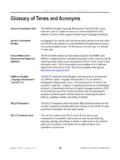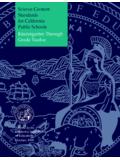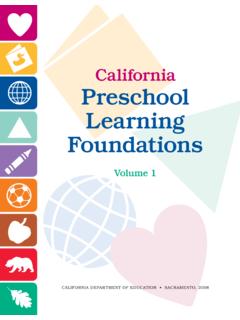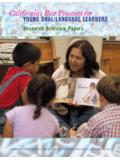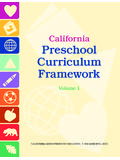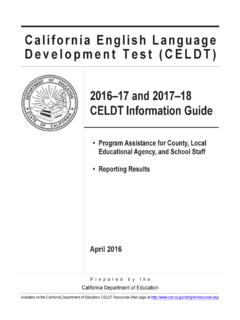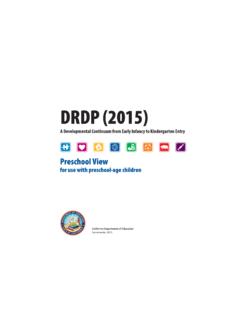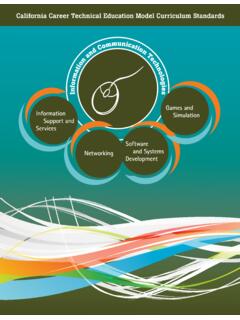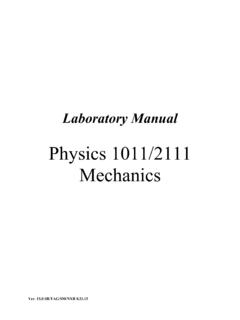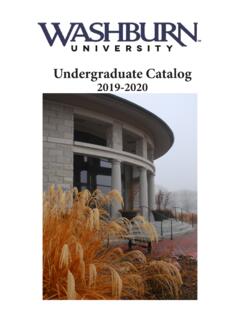Transcription of Science Safety Handbook - California Department of …
1 Science Safety Handbook for California Public Schools 2014 Edition California Department of education Sacramento, 2014. ii Contents Chapter 1. 1. A. Responsibilities of Students and Parents .. 2. B. Reasonable Laboratory Class Size .. 3. C. Reducing Risks of Injury and 6. D. State and Federal Legislation Affecting Science Instruction .. 8. E. District Emergency Procedures .. 16. Chapter 2. First Aid .. 18. A. General Information .. 18. B. Bites by Snakes, Spiders, Insects, and Mammals .. 19. C. Burns .. 22. D. Eye Injuries .. 24. E. Exposure to Poisons .. 25. F. Cardiopulmonary Resuscitation (CPR) .. 28. G. Shock .. 29. H. Universal Precautions .. 30. Chapter 3. General Laboratory Safety Precautions .. 31. Chapter 4. Safety in the Elementary Science Classroom .. 37. A. Physical Space and Class Size .. 37. B. Use of Safety Equipment .. 38. C. Making Safety a Habit .. 39. D. General Safety 39. E. Common Laboratory Operating Procedures.
2 40. F. Use of Chemicals .. 41. G. Animals in the Classroom .. 43. H. Plants in the Classroom .. 44. I. Field Trips at the Elementary Level .. 45. Chapter 5. Additional Safety Practices .. 46. A. Fire Prevention and Control .. 46. B. Use of Animals in the Classroom .. 47. iii C. Eye Safety .. 51. D. Exposure to Corrosive or Irritating Substances .. 56. E. Safety on Field Trips .. 56. F. Poisonous Plants .. 58. G. Ionizing Radiation .. 74. H. Earthquake Preparedness .. 80. I. Hazardous Waste Minimization .. 89. J. Employee Exposure to Hazardous Chemicals .. 95. K. Employee Exposure to Bloodborne Pathogens .. 97. Chapter 6. Safety in the Biology Laboratory .. 101. A. Human Blood Sampling .. 102. B. Epithelial Tissue Study .. 105. C. Use of Microscopes and Hand 106. D. Experiments with Bacteria and Fungi .. 106. E. Special Concerns in the Study of Fungi and Molds .. 107. F. Operation of Pressure Cooker for Sterilization.
3 108. G. Extraction of Chlorophyll and the Use of Flammable Solvents .. 108. H. Risks in the Use of Acrylamide .. 108. I. Risks in the Use of Ethidium 109. J. Risks in the Use of Formaldehyde .. 111. K. Instruments and Specimens Used in Dissection .. 113. L. Alternatives to Dissection .. 114. M. Handling of Laboratory 114. N. Insect Killing Jars .. 115. Chapter 7. Safety in the Chemistry 116. A. The Teacher's Responsibilities .. 116. B. The Student's Responsibilities .. 118. C. Ensuring That the Chemistry Laboratory Is Safe .. 119. D. Chemical Health Hazards .. 121. E. Steps for Establishing a Safer Chemical Storage Area .. 129. F. Labeling of Chemical 155. G. Potentially Hazardous Chemicals .. 156. H. Substances Containing Asbestos .. 159. iv I. Use and Disposal of Ethers .. 160. J. Standards in the Use of Lead .. 161. K. Handling and Cleanup of Mercury .. 163. Chapter 8. Safety in the Physics 165.
4 A. General Safety Practices .. 165. B. The Student's Responsibilities .. 167. C. Electrical Devices and Connectors .. 168. D. Model Rocket Launchings on School Sites .. 169. E. Use and Hazards of 170. Appendices A. Legal Citations .. 179. B. Sample Safety Regulations for Science Students; Student Science Safety Agreements .. 239. C. Science Laboratory Safety 253. D. List of Incompatible Chemicals; Sample Chemical Inventory .. 256. E. Sample Science Laboratory Safety Test .. 261. F. Sample Safety Checklist for Science Instruction, Preparation, and Storage Areas .. 269. G. End-of-Year Safety and Energy-Savings Procedures .. 273. H. The California Poison Control System .. 275. I. Reimbursement for Removal and Disposal of Chemicals .. 277. J. Safety Precautions for Rocket Launchings on School Sites .. 282. K. Science Classroom First-Aid and Safety Materials; Sample Accident Report .. 287. L. Sample Field Trip Permission Slip.
5 289. M. Outbreaks of Coccidioidomycosis Associated with Field Work .. 291. N. Certified Unified Program Agency (CUPA) Directory Web Site .. 293. O. Managing Empty Containers .. 294. P. Sample Biological Science Laboratory Regulations .. 297. Q. Carcinogen Report of Use 301. R. Department of Transportation Hazard Classes .. 305. S. Sample Physical Science Laboratory Regulations .. 311. Bibliography .. 316. v Tables Recommended Supplies of Safety Devices for Eyes .. 53. Effects of Some Poisonous Plants .. 59. Chemicals Causing the Most Common Accidents in Schools .. 123. Explosive Chemicals .. 133. Extremely Hazardous Chemicals Requiring Prompt Disposal .. 148. Categories of Compatible 153. Classes of Lasers .. 172. Figures Sample Layout of Preparation/Storage Area .. 155. Sample Label for a Chemical Container .. 156. NFPA Symbol on a Chemical Container .. 157. vi Acknowledgments Many representatives of various state agencies and educational and research institutions dedicated their time to make this Handbook possible.
6 The coordinators and developers of the 1999 edition are gratefully acknowledged. Contributors to the 1999 Edition Doug Adams Philip D. Gay (Retired). Safety Office San Diego City Schools San Diego City Schools Jack Gerlovich Donald B. Alger Drake University Chemistry Department California State University, Chico Stuart Greenfield Assistant Superintendent William H. Andrews High School Division Consultant California Department of education Environmental education Office California Department of education David Hammond (Retired). High School Curriculum Unit John Baker California Department of education Safety Office San Diego City Schools Jack Grube Science Laboratory Specialist Project Robert A. Cervantes Administrator Barbara Hemmingsen Curriculum Development Unit San Diego State University California Department of education Sonia Hernandez Frank Ciofalo Deputy Superintendent California Occupational Safety and Health Curriculum and Instructional Leadership Administration Branch California Department of education Patricia Coyle Associate Toxicologist J.
7 Scott Hildum Health Evaluation System and Information Lawrence Livermore National Laboratory Services California Health and Welfare Agency Sheila Mackenzie Mathematics, Science , and Environmental Dennis Fisher education Unit Lawrence Livermore National Laboratory California Department of education Judi Frantz Jack S. McGurk Department of Toxic Substances Control Department of Health Services California Environmental Protection Agency Sacramento vii Les Michaels Jim Stratton Health and Technical Services Office of Environmental Health Hazard California Occupational Safety and Health Assessment Administration California Department of Health Walter Milne Fran Stricker California Institute of Technology Animal Protection Institute Robert Nakamura Jim Tripod Special Studies Unit Environmental Health and Safety Office California Occupational Safety and Health University of California , Irvine Administration Susan Wainwright Willa D.
8 Ramsay Mathematics, Science , and Environmental Madison High School, San Diego education Unit California Department of education Barbara Rohde Department of Toxic Substances Control Jon Rosenberg Health Evaluation System and Information Services California Health and Welfare Agency Note: The titles and affiliations of the persons included in this list were current at the time the 1999. edition was developed Contributors to the 2012 Edition Judith Alsop Shelley DuTeaux California Poison Control System California Air Resources Board Lucy Chaidez James Greco California Emergency Medical Services education Administrator Authority Science , Technology, Engineering, and Mathematics Office Triss Chesney California Department of education Brownfields and Environmental Restoration Program Phil Lafontaine Department of Toxic Substances Control Director Professional Learning Support Division Jeanine Clasen California Department of education Deputy General Counsel Legal Division Robert Nakamura California Department of education California Occupational Safety and Health Administration Rupali Das Exposure Assessment Section Caz Scislowicz Environmental Health Investigations Branch Director.
9 Health and Safety California Department of Public Health California Institute of Technology viii Patricia Terry Thomas Tooker education Programs Consultant Consultant California Department of education School Facilities and Transportation Services Division California Department of education A special acknowledgment goes to Dean Gilbert, Math/ Science Consultant, Los Angeles County Office of education , for his review of the draft version of this document. Note: The titles and affiliations of the persons included in this list were current at the time the 2012 edition was developed. Contributors to the 2014 Edition Chris Breazeale Stephanie Pappas education Programs Consultant School Health education Consultant Science , Technology, Engineering, and Coordinated School Health & Safety Office Mathematics Office California Department of education California Department of education Anne Stephens Debbie Decker education Programs Consultant Safety Manager Science , Technology, Engineering, and Department of Chemistry Mathematics Office University of California , Davis California Department of education Shannon Gordon Diane Waters education Programs Consultant Senior Architect Science , Technology, Engineering, and School Facilities and Transportation Mathematics Office Services Division California Department of education California Department of education Note: The titles and affiliations of the persons included in this list were current at the time the 2014 edition was developed.
10 Ix x Chapter 1. Introduction Laboratory activities and demonstrations represent an essential part of effective Science teaching. Written materials and pictures can convey an enormous amount of information, but students more fully understand the concepts related to Science when they participate in or observe learning activities involving laboratory experiments and demonstrations. In addition, those activities allow students to learn the processes and techniques of Science laboratory investigation. Students who go to colleges and universities and take advanced Science courses are expected to know laboratory procedures. The Science Framework for California Public Schools, Kindergarten Through Grade Twelve, states, Hands-on activities may compose up to a maximum of 20 to 25 percent of the Science instructional time in kindergarten through grade eight. 1. Although many Science activities present potential hazards, reasonable and prudent Safety practices greatly reduce the likelihood of accidents.

